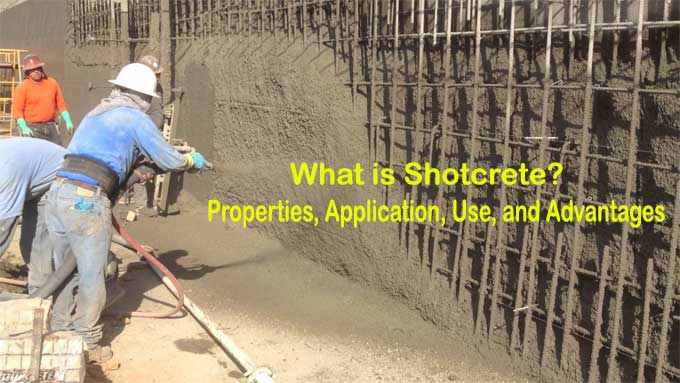
Define Shotcrete and its uses in Construction
Shotcrete is mortar or fine concrete deposited by jetting it with high velocity onto a arranged surface. Shotcrete put forward advantages over conventional concrete in a various new construction concrete due to fewer formwork requirements, requiring only a small portable plant for manufacture and placement.
It is capable of excellent bonding with materials. That may be a vital consideration.
As with other concretes, shotcrete also requires ample curing for the cracks prevention. Adequately cured spray concrete can manage strengths around 450-550 kg/cm2 at 28 days.
Different Processes of Shotcrete
I. Dry mix process
II. Wet mix process
Dry Mix Process
In this process, the cement mixture and damp sand transmit through a delivery hose pipe to a mechanical feeder or gun is called delivery equipment.
- The mixture distributes into the delivery hose by a feed wheel or distributor. This material carries with compressed air perforated manifold where water commences under pressure and mixed with other ingredients.
- The mortar jetted from the nozzle at high velocity onto the surface to be shotcrete. In this process, any alteration in the water quantity can easily accomplish by the nozzle man.
- More water leads to concrete slump while jetted onto the vertical surface. Water adjusted in certain level that the material wastage is rebounding is less. The water-cement ratio is in range of 0.33 and 0.50.
- This technique allows several equipments from Shotcrete. The equipments guarantee an incessant mortar supply that can transmit the material to a distance of 300 to 500 m horizontally and 45 to 100 m vertically.
Wet Mix Process
In this process, all the ingredients like cement, sand, small-sized coarse aggregate, and water blend before entering the chamber of delivery equipment.
- The ready mixed concrete gauge into 7 atmospheres to a nozzle, additional air is injected at the nozzle to increase the velocity and improve the running pattern. Gear capable of placing concrete at the rate of 3 to 9 m3/hour is available.
- The falling back phenomenon of mortar or concrete jetted onto the surface indulgenced due to the high velocity of the jet is called rebound and depends upon the water-cement ratio.
- The estimated rebound range is 5 to 15% for horizontal slabs, 15 to 30% for sloping and vertical surfaces, and 20 to 50% for the treatment of overhead surfaces and corners.
- The dry mix process prefers in case the lightweight concrete use. The lower water-cement ratio in higher strengths is used in less creep and drying shrinkage, and higher durability. Higher durability can achieve by using air-entraining agents can achieve in the wet process.
- When the water-cement ratio can accurately control the wet process, it does not cause most due problems. The larger capacity accessible in the wet mix process results in much higher rates of concrete placing.
Properties of Shotcrete
- A small maximum size aggregate used and cement content is high.
- It should enhance durability in most cases.
- Whereas conventional concrete consolidates by vibration.
- The impact of a high-velocity jet impinging on the surface consolidates shotcrete. Due to rebound, this process increases the cement content also brings about different air void systems. That is affecting the shotcrete durability.
- The application procedures have an impact on the in-place properties of shotcrete than the mix proportions.
- Shotcrete specimens usually sawed from test panels of about 1meter square and 75 mm thick made by gunning out plywood.
Shotcrete Applications
- Shotcrete wide used in different construction like thin overhead vertical or horizontal surface, particularly the curved or folded sections, canal, reservoir, and tunnel lining.
- It also use in swimming pools, water retaining structures, and pre stressed tanks.
- Shotcrete has been successfully used in rock stabilization slopes and temporary protection of freshly excavated rock surfaces.
- It is utilized in protection against long-term pilling corrosion, coal bunker, oil tanks, steel building frames, and other structures like encasing structural steel for fireproofing.
- These developed for high-temperature applications, such as the refractory lining of kilns, chimneys, furnaces, etc.
Advantages of using Shotcrete
- The Concrete can apply by a nozzle from a safe distance.
- More economical than conventional concrete requires less formwork.
- Excellent bonding in nature which makes the concrete layers very strong.


